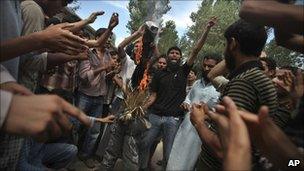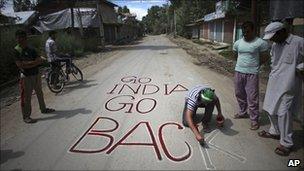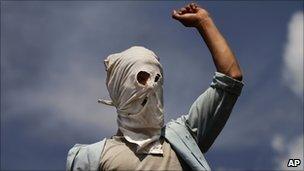Why Kashmir is again on a knife-edge
- Published

2010 has been characterised by ongoing protests
Whether they are being listened to or not, the people of Indian-administered Kashmir have been making a point every day for the past two months - they are tired of the status quo.
Twenty years after massive peaceful protests on the streets of the Kashmir Valley were superseded by violence, the people have hit the streets again - and not without good reason.
About 50 people, mostly students, have been killed in sporadic police shootings since the death on 11 June of a Srinagar teenager, Tufail Ahmed Mattoo, who was killed by a tear gas shell as he returned home from class.
Mattoo, who was just a few days shy of his 18th birthday, died after security forces opened fire on an anti-India demonstration, but locals say he was not involved in the protest.
He was one of many teenagers who have fallen victim to Indian policemen and paramilitaries in Srinagar and other parts of the Kashmir Valley in the last two months.
Religious tensions
There has been a depressing cycle of protests, death, violence at funerals and more deaths.
And across Indian-administered Kashmir ordinary people - children, women and men - have been taking on police personnel.
What are their grievances?
After elections to the state assembly at the end of 2008, where Indian Kashmir saw a turnout of 60%, a popular government headed by Omar Abdullah - grandson of modern Kashmir founder Sheikh Abdullah - took power.
Kashmiris, Delhi felt, were now part and parcel of Indian democracy.
The elections came soon after protests over the planned transfer of some land near the Amarnath shrine, one of the holiest shrines of the Hindu religion.
The state government proposed the transfer of forest land to organisers of pilgrimages to the site, triggering controversy and anger.
The authorities dropped the plan following Muslim protests, and then found itself subjected to Hindu demonstrations protesting that decision.
At least five people were killed in the protests.
The following year - in May 2009 - the Valley was rocked by allegations that two women had been raped and killed by the security forces.
Autonomy push
And this year has been characterised by a seemingly never-ending series of street protests.
The approaching month of Ramadan may be the only thing that will dampen violence that has been raging since June.
"What we are seeing is a massive eruption of discontent that can turn into an insurgency," Wajahat Habibullah, a former chief secretary of Indian-administered Kashmir, told the BBC.

Anti-Indian sentiment is growing stronger among young people in the region
"It shows that the leaders of Kashmir have lost contact with the people."
Sarwar Kashani, a young Kashmiri journalist based in Delhi, believes the sentiments which fuelled the Valley boycott of Indian elections in 1989 have not changed.
"The rejection of the status quo remains," he says.
For 20 years, the Indian state battled hard to deal with the militants. Now they have to deal with the people again.
This time they are confronted with a largely leaderless mob - very different from fighting an insurgency.
Over the last 20 years, many Indian prime ministers and leaders have promised the people of Kashmir different forms of autonomy.
In 2006, Prime Minister Manmohan Singh set up five different committees to address their problems.
But all these have come to nothing.
The dialogue with Kashmiri leaders is off and the peace process with Pakistan is in limbo.
'Insufficient troops'
"Not a single thing has come by way of autonomy to the people of Kashmir," Anuradha Bhasin, executive editor of the Kashmir Times newspaper, told me.

In the past such tensions in Kashmir would have gained worldwide attention
"All of it has been put in cold storage. The government of India is not serious."
The khaki uniform and the bunker, Mr Kashani argues, are the only things that a new generation of Kashmiris, who grew up in the era of curfew and crackdown, know of India.
It is this generation that is now hurling stones at Indian security personnel.
Raouf Rasool, an analyst based in Srinagar, rejects the contention that the protests have been inspired from across the Line of Control (in Pakistan).
But he says that non-state actors could be trying to influence the protests.
E N Ram Mohan, a former Indian police official who dealt with militancy in the 1990s in Kashmir, told the BBC that Chief Minister Abdullah was incapable of handling the situation.
"Where are the 20-plus battalions of the state-armed police?" he asked. "We have not seen them on the streets - only the Central Reserve Police Force is visible."
A former Indian intelligence official, who preferred anonymity, said: "If you open fire at people who are throwing stones, you are asking for trouble."
International attention
The government of India is lucky that the international focus on Kashmir is virtually non-existent.
Some years ago, this would have been a big issue. British Prime Minister David Cameron did not use the K word (Kashmir) during his recent trip to India, but instead chose to talk about Pakistan.
In the 1990s, Western countries would often refer to the disputed nature of the entire territory of Jammu and Kashmir.
But, in the post-9/11 world, militancy has lost its sheen.
The one-time champion of the Kashmiri cause, Pakistan, whose intelligence agencies propped up militant groups in the 1990s, has also lost much of its international credibility.
In short, much of the world is not interested in Kashmir or the Kashmiris.
The expansion of the Indian economy is another reason why the world does not want to anger Delhi.
Indian officialdom can be quick to take offence and Western officials now seem to want to accommodate Delhi on Kashmir.
In the end, it is not international attention (or the lack of it) that should govern Delhi's Kashmir policy.
The world's largest democracy, and its civil society, must understand that stones cannot be met indefinitely by more bullets.